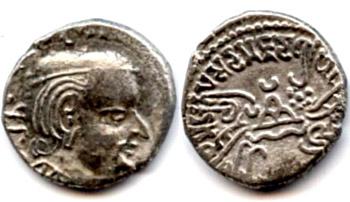 The records reveal existence of two such dynasties -the Ksharatas and the Castana. Sakas in Western India were generally called the Kshatrapas of Saurashtra and Malwa. The Parthian invasion of the Indus valley put an end to the rule of the Sakas in the Punjab and the North-Western Frontier Province. This produced an indirect result on the politics of North India. The Sakas became scattered and a branch of them moved towards the south and carved a kingdom for in the western part of India. The chief centre of their power was in Malwa. Ksharatas dynasty was the earliest and the short-lived one consisting of two members - Rhumaka and Nahapana. The inscriptions reveal that the Ksharatas had their homes in Taxila and Mathura from where they migrated to the south under the pressure of the Parthians.
The records reveal existence of two such dynasties -the Ksharatas and the Castana. Sakas in Western India were generally called the Kshatrapas of Saurashtra and Malwa. The Parthian invasion of the Indus valley put an end to the rule of the Sakas in the Punjab and the North-Western Frontier Province. This produced an indirect result on the politics of North India. The Sakas became scattered and a branch of them moved towards the south and carved a kingdom for in the western part of India. The chief centre of their power was in Malwa. Ksharatas dynasty was the earliest and the short-lived one consisting of two members - Rhumaka and Nahapana. The inscriptions reveal that the Ksharatas had their homes in Taxila and Mathura from where they migrated to the south under the pressure of the Parthians.
Ksaharata dynasty
The coins reveal that Bhomaka preceded Nahapana. His coins have been found in Gujarat, Kathiawad and the Malwa region. Bhumaka tentatively place the beginning of Bhumaka`s reign sometime between 50 and 60 A.D.
Nahapana was an important ruler of the Western Kshatrapas, descendant of the Indo-Scythians, in northwestern India. According to one of his coins, he was the son of Bhumaka. There is absolutely no evidence to prove that Nahapana was in any way subordinate under the Kusanas. The geographical references in the inscriptions of Usavadata, the son-in-law of Nahapana reveal that the latter`s rule extended from Ajmer and Rajputana to Kathiawad in South Gujarat, Western Malwa, North Konkan, from Broach to Sopara, and Nasik and Pune districts.
The Periplus states that Minnagara was the capital of the Nahapana`s kingdom. The evidence of the Periplus also shows that during the rule of Nahapana a flourishing trade was going on between India and the western countries. Commodities flowed to Broach through Ozene, Paethan and Tagara. This shows that once king Nahapana was a man of fashion with tastes of luxury as the items for the King were imported. Some inscription discloses that Nahapana was conquered by the Satavahana kings. It can safely be inferred that Nahapana was the last prince of the Ksaharata dynasty.
Dynasty of Castana
The second family of the Sakas of Ujjayani and Kathiawad - the Castana was destined to rule for centuries. They played an important role in the political and cultural history of Western India. In the epigraphic records Castana is portrayed as the son of Ysamotika. The term `Ysamo` is Scythian which means territory. Hence Castana is considered as a relative of Nahapana, though this is a controversial view. There is no doubt that Castana was an independent monarch and his dynasty uses the Saka era in the inscriptions and coins. The earliest known date of the dynasty is 52 -130 A.D according to Andau inscriptions while the latest date known from the coins is 310 - 388 A.D. which falls within the rule of Chandragupta, who overpowered the Sakas in India.
The coins of Castana bear inscriptions in Brahmi and Kharosthi characters. The Andau inscriptions of 130 A.D. show that Castana had been ruling with his grandson Rudradaman. Rudradaman was the greatest king of his dynasty. His Junagadh records furnish us with the election of Rudradaman as the king, Conquests made by Rudradaman, in Southern and Northern India, History of the Saurashtra region and Administration and personal qualities of the king.
Rudradaman earned for himself the title of mahaksatrapa. He is described as being an object of devotion to the people of the East and West Malwa, Mandhata in Nimad, the region round Dwaraka, Saurashtra, country on the banks of Sabarmati, Marwar, the Indus valley , North Konkan , region of the Sarasvati and the Western Vindhyas .The Junagadh record states that Rudradaman defeated Satakarni twice, the lord of the Daksinapatha. Rudradaman was a benevolent king with intense love for humanity.






































